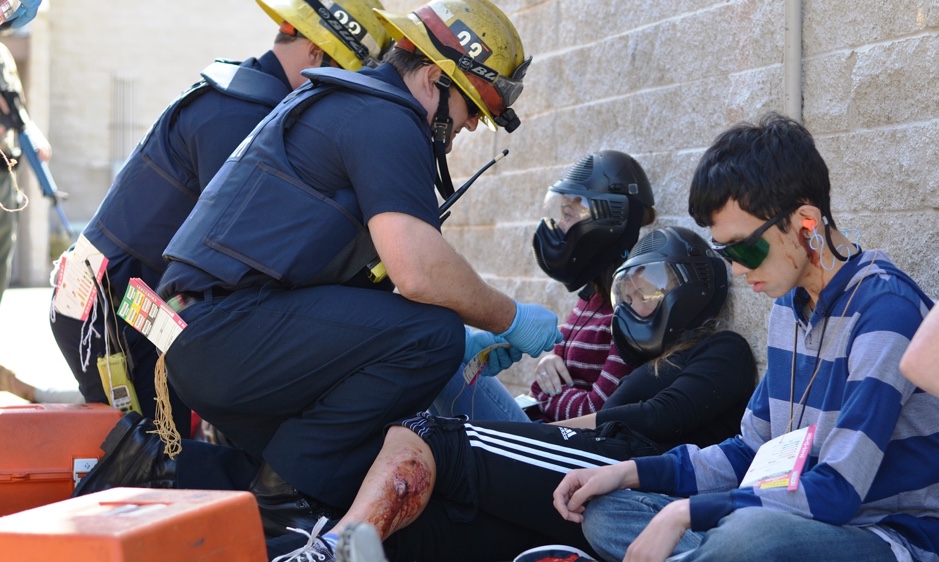Transforming Tactical Combat Casualty Care to Civilian Providers via Medical Simulation
Today’s emergency casualty care builds on lessons learned in the wars in Afghanistan and Iraq and active shooter and mass casualty tragedies in the civilian world. Lessons learned from tactical combat are crucial for the civilian space to understand and train for in today’s world. This information transfer has led to unique government supported initiatives and innovative training products which are crucial for healthcare simulation programs to understand and incorporate. Here below, Strategic Operations’ Kit Lavell and Wyatt Sabo, MS HSEM, CHSE review the latest developments in education, training and medical simulation technologies designed to save lives in our contemporary world.
Tactical Combat Casualty Care (TCCC) guidelines were developed more than twenty years ago but matured during the wars in Afghanistan and Iraq. TCCC is based on Care Under Fire, Tactical Field Care, and Tactical Evacuation Care to address the three most preventable causes of death on the battlefield (and as discussed below, also on highways, in industrial accidents and active shooter and mass casualty tragedies): hemorrhage; tension pneumothorax; and airway obstruction (Butler, 2017). The TCCC skills have been proven safe and effective, and even somebody without medical training can perform them.
Massive hemorrhage is controlled with tourniquets, hemostatic dressings, junctional devices, and pressure dressings. The airway is managed by the rapid and aggressive opening of the airway to include cricothyroidotomy for difficult airways. Respiration and breathing are managed by the assessment for tension pneumothorax and the aggressive use of occlusive dressings and needle decompression devices to relieve tension and improve breathing.
Sponsored Content:
As TCCC was applied in Afghanistan and Iraq in Role 1 Care (immediate and at a battlefield Medical Treatment Facility), the survival rate for a preventable death wounded, i.e., someone who was not killed outright, was about 95%. A preventable death is someone who has died from massive extremity hemorrhage, a tension pneumothorax, and/or airway obstruction. This was a significant increase over previous wars and resulted from TCCC being applied in the “Golden Hour” before being evacuated to Role 2 Care for surgery.
Over the last decade or more, TCCC techniques have filtered down to civilian trauma treatment and training, especially the use of tourniquets, hemostatic dressings, junctional devices, and pressure dressings. On October 6, 2015, the White House unveiled its “Stop the Bleed” campaign to encourage bystanders to act as immediate responders. Collaborating with the Departments of Homeland Security and Health and Human Services, FEMA, the private sector, nonprofits, and the medical community, the “Stop the Bleed” initiative aims at raising awareness of life-saving techniques and providing public access to tools for bleeding control already used by EMS and the military.
Additionally, this campaign is a culmination of partnerships between the National Security Council at the White House, American Heart Association, American Red Cross, American College of Surgeons (ACS), Hartford Consensus, National Association of Emergency Medical Technicians (NAEMT) and others. “Stop the Bleed” campaign’s goal is to train millions of Americans over the next decade.
Since its release date, June 25, 2019, the 2nd edition of the (NAEMT) Tactical Emergency Casualty Care (TECC) course teaches EMS practitioners on all levels how to respond to and care for patients in a civilian tactical environment. TECC is a set of best practice treatment guidelines for trauma care in high-threat prehospital settings. The guidelines are built from lessons learned by the U.S. and allied military forces in Iraq and Afghanistan and were brought to the civilian sector via the Committee on Tactical Combat Casualty Care (Co-TCCC).
Sponsored Content:
Train for TCCC with Nasco’s Rescue Randy
Nasco Healthcare recently introduced the Casualty Care Rescue Randy, an affordable, rugged, field-deployable, full-body manikin designed for enhanced realistic training on TECC procedures, powered by Strategic Operations Hyper-Realistic technology. The Casualty Care Rescue Randy is designed for use by civilian EMS, EMT, Law Enforcement and other civilian and military medical first responders.
The manikin has articulated joints, mimics a human body’s weight distribution, holds three to four liters of simulated blood, has a foot-operated pump (an electronic pumping system is optional) to deliver blood to femoral, brachial, inguinal and carotid wounds, and allows for treatment interventions using extremity and junctional tourniquets, wound packing and pressure bandages. Airway management is accomplished with Nasopharyngeal, Oropharyngeal, and Cricothyroidotomy. Tension pneumothorax with Needle Decompression at the 4th/5th intercostal space in the anterior axillary line and at the 2nd/3rd intercostal space in the mid-clavicular line. A penetrating chest wound allows for an occlusive dressing to be applied.
The Casualty Care Rescue Randy’s skin is user repairable, and unlike other manikins, it does not have a “target” that “guides” the provider where to place the needle. The provider must visually locate and properly palpate to determine correct placement. Casualty Care Rescue Randy comes with simulated blood, repairable neck skins, repairable tracheas, and a repair kit. There is a tremendous need for realistic, user-repairable manikins to teach first responders proper tactical medicine techniques – that are affordable – and rugged enough to be used in the field.
“We use Casualty Care Rescue Randy manikins in the classroom and field portions of our NAEMT and POST-certified tactical medicine courses,” says Wyatt Sabo, Medical Training Program Manager at Strategic Operations in San Diego. “First responders can practice life-like training solutions for real-life situations.”
Expansion of Specialized Training for TCCC from the DHA
Last summer, the Assistant Secretary of Defense for Health Affairs chartered a working group of members of the Defense Health Agency (DHA) and other military services responsible for developing a structured Tactical Combat Casualty Care (TCCC) curriculum for all service members (ASM). TCCC ASM was released on August 1st and will be the first level of four-tiered standardized TCCC curricula to be completed. The TCCC ASM course follows the MARCH algorithm and covers five lifesaving skills (rapid casualty assessment, tourniquet application, hemostatic dressing, pressure dressing, and airway maneuvers) over 6 hours that will serve both as the minimum standard of care for all service members and act as the foundation for the four-tiered TCCC program (Remley, 2019).
The second tier, Combat Lifesaver (CLS), was released on December 31, 2019 and follows MARCH PAWS, which helps familiarize TCCC concepts and lifesaving skills to render medical aid to a trauma casualty. The course provides information through a short lecture followed by interactive, hands-on training and formal evaluation. The CLS TCCC Course encompasses tactical trauma assessment, bleeding control interventions, airway and respiratory management techniques, and proper lift, drag, and carry methods. The course also covers the prevention and treatment of shock, burns, eye injuries, splints, pain management, critical communication, and medical documentation practices. Upon completion of this 40-hour course, students will be qualified at a TCCC basic level.
They are based on the MARCH PAWS algorithm:
M – Massive bleeding Pain
A – Airway Antibiotics
R – Respiration Wounds
C – Circulation Splint
H – Hypothermia/Head
Strategic Operations is an authorized NAEMT Training Center that hosts numerous medical training courses; LEFR, TECC, TCCC, and TMT. The Law Enforcement First Response (LEFR) is a course that teaches first responders and allied professionals the primary medical care interventions, which can save an injured person’s life until conventional EMS arrives. The TECC 2nd edition course delivered by STOPS is certified by the ACS and is consistent with the most current guidelines established by C-TECC.
The 40-hour Tactical Medicine Technician (TMT) course prepares SWAT medics and Rescue Task Force (RTF) deployments to mass casualty and active shooter situations. Strategic Operations uses the crawl, walk, run teaching methodology that takes the students from the repetitive practice of core TACMED skills and progress through the full hyper-realistic stress inoculation scenarios using the Casualty Care Rescue Randy.
Learn More About Rescue Randy from Nasco!
References:
- Butler, F. K. (2017). Two Decades of Saving Lives on the Battlefield: Tactical Combat Casualty Care Turns 20. Military Medicine, 182(3/4), e1563–e1568. https://doi-org.nuls.idm.oclc.org/10.7205/MILMED-D-16-00214
- Feldman, R. (2019). Committee for Tactical Emergency Casualty Care. http://www.c-tecc.org/about/overview
- Remley, M. (2019). Changes Coming to TCCC Training. Infantry 108(2), 47-49. Retrieved from http://search.ebscohost.com.nuls.idm.oclc.org/login.aspx?direct=true&db=mth&AN=138564518&site=ehost-live
- Stop the Bleed – Campaign – AEMS. https://www.aems.org/stop-the-bleed-campaign
- Tactical Combat Casualty Care Guidelines (2019). Committee on Tactical Combat Casualty Care (CoTCCC).
- Tactical emergency casualty care (TECC): Course manual (2nd ed.). (2020). Burlington, MA: Jones & Bartlett Learning.
Today’s article was guest authored by Kit Lavell, Executive Vice President and Wyatt Sabo, MS HSEM, CHSE, Director of Medical Training and Simulation, at Strategic Operations, Inc. Have a story to share with the global healthcare simulation community? Submit your simulation news and resources here!
Sponsored Content:
















